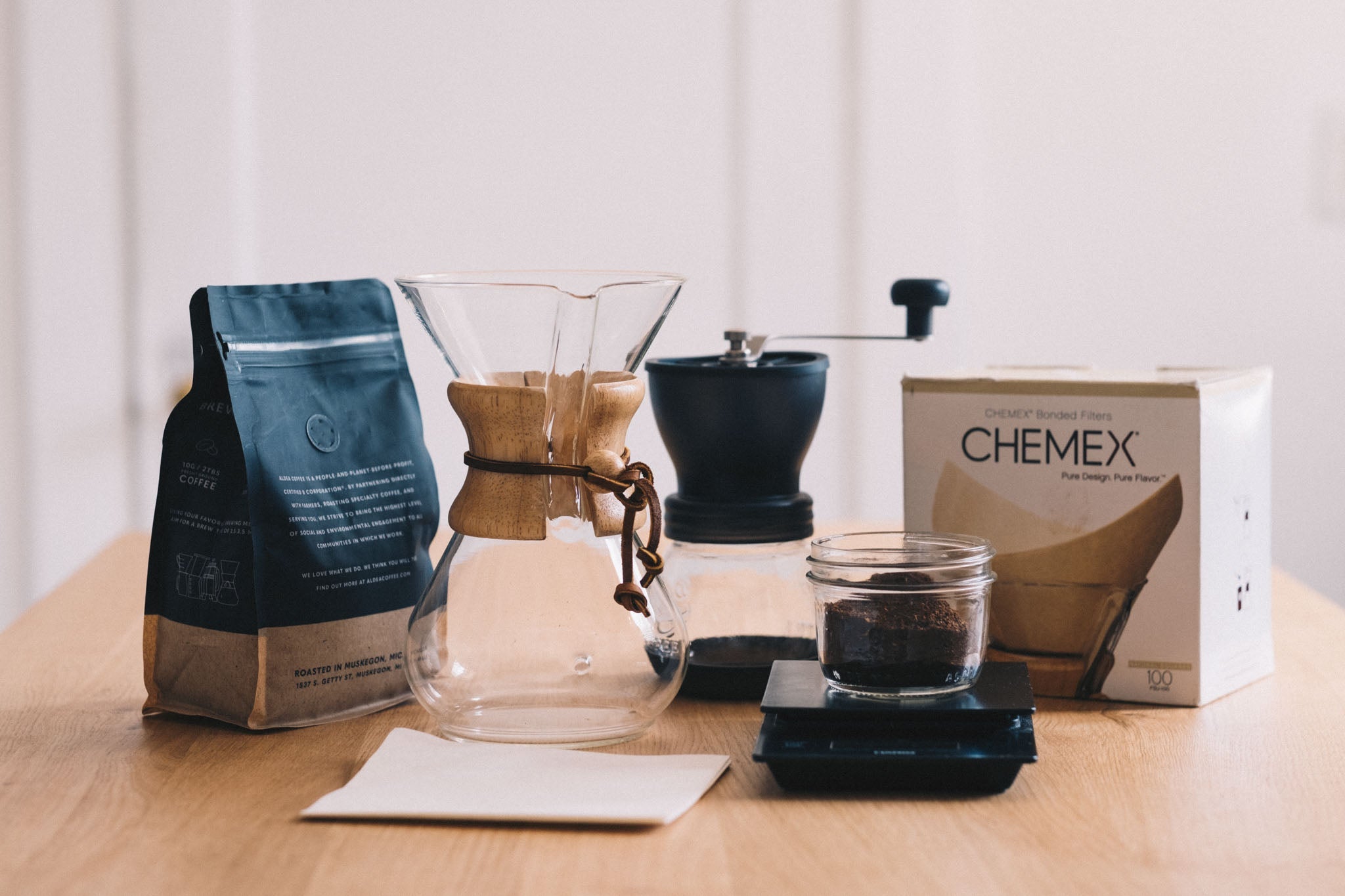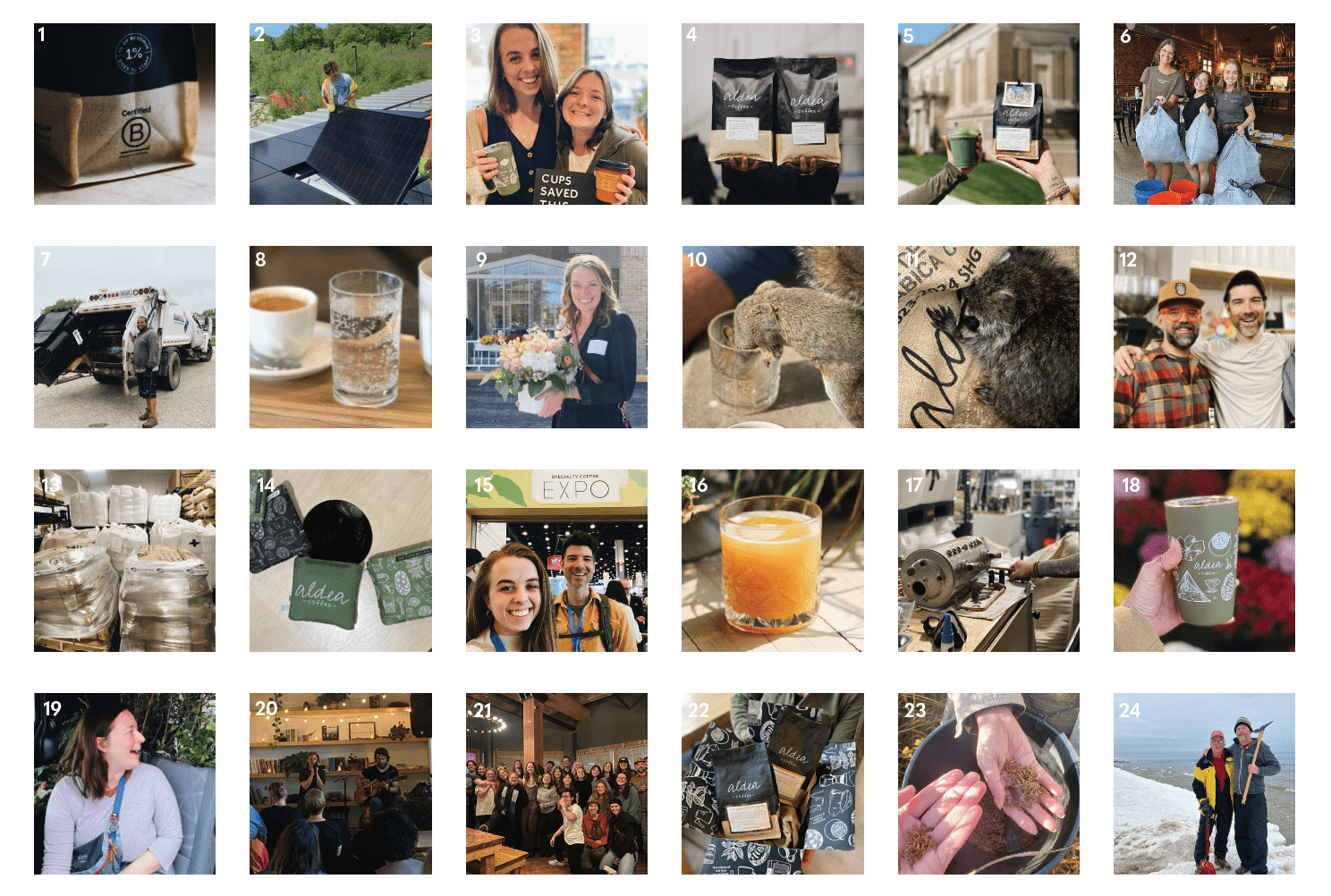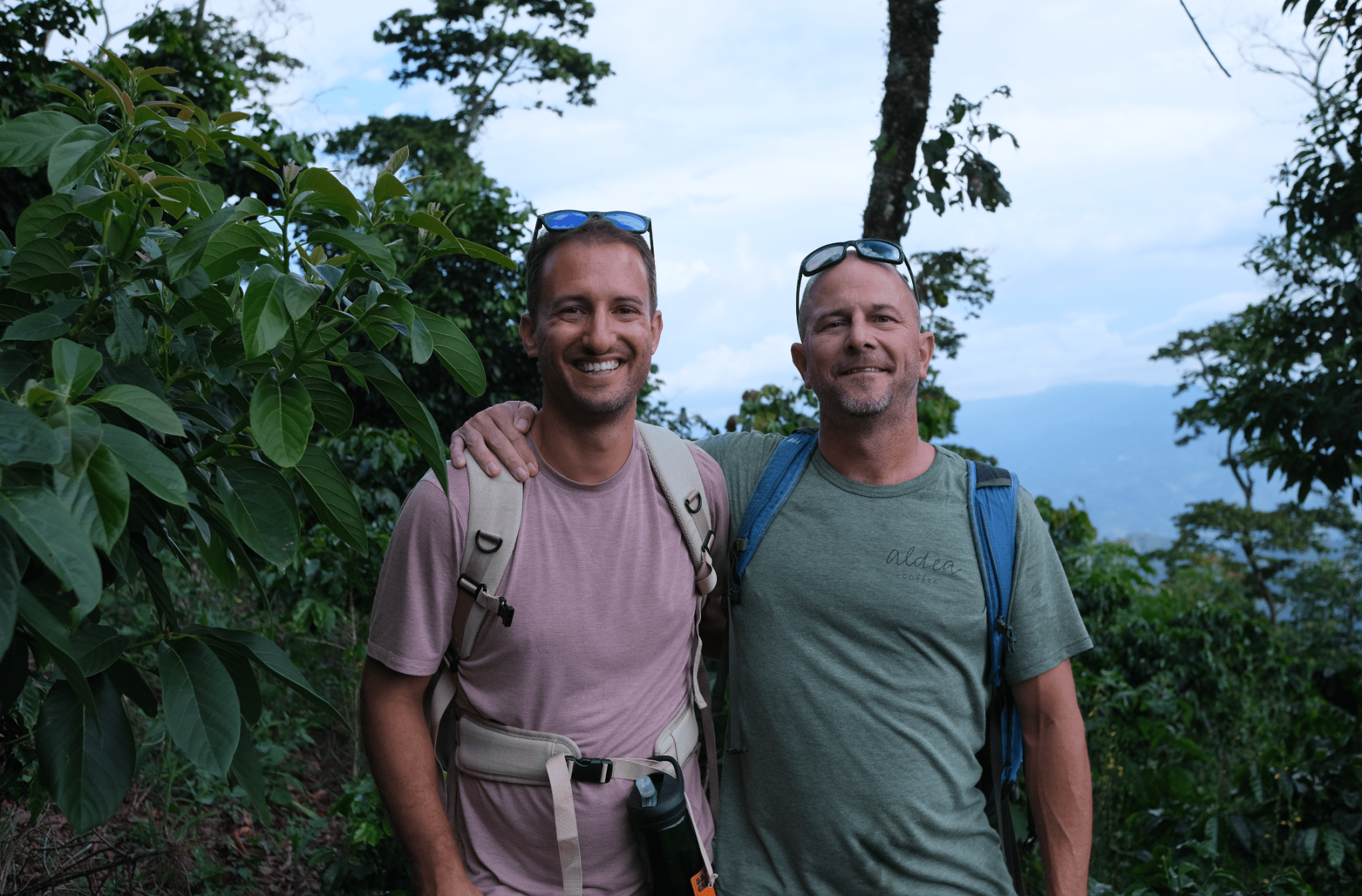
Overview
Monthly Features
Filter (Drip):
Pour-Over:
____________________________________________________________

Coffee Fun Fact
We roast all our coffee on a Diedrich IR-12 in Muskegon, MI. Although the max capacity of the roaster is 12 kilograms, you can only roast about 9 kg of green coffee per batch (or 75% capacity). This is because coffee nearly doubles in size during the roasting process, going from a green fruit pit that is as hard and dense as a tooth, to a grindable, chocolatey bundle of goodness in about 12-minutes time. You need to save space for all that expansion. In all, our roaster produces about 15-18 pounds per roast. We are truly a small batch roastery.
____________________________________________________________

OCTOBER RELEASES & RUNOUTS
October Runouts
Roaster’s Pick: Finca El Espejo | Estimated Runout Date: October 6.
This was truly a limited release. Glad it was well-received! Stay tuned for our next Roaster’s Pick coming out in the beginning of 2025.
September Releases (In case you missed it!)
Gilberto Barrientos | Release Date: September 13th
Gilberto Barrientos's coffee is back in action with a cozy medium/dark profile that highlights its deep chocolate character and nuttiness. This was a big hit last year, and it's yet another wonderful harvest from Aldea Development's Director of Coffee Quality and specialty coffee training program in Honduras, nine years and running!
Carlitos Heins Washed | Release Date: September 20th
Keep the applause going for Carlitos Heins! Back for the sixth year, this is another great harvest from the President of Aldea Development. This washed process coffee is well-balanced with rich notes of cocoa, orange citrus, and some characteristic earthiness. Charlie Heins, aka Carlitos ("Little Charlie"), is from Spring Lake, MI, but now lives in Honduras with his family where he plays an important role for Aldea Coffee, coordinating the procurement, processing, and transportation of all the coffees we receive from Honduras.
Carlitos Washed will be our Pour-over feature for the month of October. Get it while you can!
____________________________________________________________

Downshifter Half-Caff
Release Date: October 5th
That’s right. Back by popular demand, the Downshifter Half-Caff is back, back, back, and better than ever.
Originally released in limited supply in our Roaster’s Pick Line at the end of last year, this half-caff blend was a hit with its fudgy richness and full body with only half the caffeine of your average cup of coffee.
The Downshifter still features our highly admired E.A. Decaf but is now blended with a robust Washed Honduran lot from our partners in La Union, giving it a slightly bigger body, a balancing toasted almond quality, and a lasting sweet chocolate pie finish. It’s delicious, y’all, and is now a favorite in my household. It can be enjoyed any time of day, but I prefer it as a post-lunch treat to help me get back in gear without the spike/crash cycle, or the potential restless night of sleep that can come with having too much caffeine too late in the day.

About The E.A. Decaf in The Downshifter
If you haven’t had it, our decaf is awesome. Coming from the beautiful, green mountains of Huila, Colombia, and brought to us by our friends at Coffee Quest USA, this communal lot is a blend of coffees from several wonderful small-scale producer in Santa Maria and Pitalito, some of whom we got to meet when we visited the region a couple years ago. Each coffee undergoes a meticulous selection process at the Coffee Quest labs around Huila before being sent off to the dry mill where they are sorted, blended and then trucked to an E.A. decaffeination facility just down the road.
What’s that now? E.A.?
E.A. stands for ethyl acetate, a vinegar solution that is made by fermenting sugar cane, another burgeoning cash crop in Colombia, like coffee. Ethyl acetate is a natural solvent used in the decaffeination process and is safe for human consumption (and is often used as a flavor enhancer in the food industry). To make matters better, the coffee is decaffeinated right down the road from the dry mill in Medellin. For these reasons, EA Decafs are one of the most sustainable decaf methods in the world as they are decaffeinated at origin instead of far, far away (such as in Canada, where the majority of Swiss Water Decaf is processed), decreasing its overall transit time and carbon footprint.
To make them even cooler, E.A. Decafs are delicious because they keep most of their “origin” flavors and even enhance the overall sweetness a bit compared to other decaffeination processes.
In other words, EA = extra awesome. And, so is the Downshifter. Try it on drip at either cafe throughout the fall.
____________________________________________________________

At-Home Coffee Brewing Tips with Scott
Some of the fun (and frustration) with coffee is all the ways you can brew it. Sometimes you buy a coffee from your favorite roaster only to find that it doesn’t taste quite like it did at the shop. Or, one morning you just knock it out of the park—you make a perfect pour-over, French Press, drip brew, or whatever but can’t seem to recreate that experience the next day—why?
I put together a few universal brewing tips to help you create (and recreate) a solid cup of coffee at your home again and again. Let’s start from the top:
1) Use Freshly Roasted Coffee (But Not Too Fresh)
Firstly, there are two ways of looking at the coffee consumption timeline: shelf life vs. peak flavor. Per shelf life: whole bean coffee (not ground), if stored in a dark, cool, dry environment in an airtight package (like our bags), is totally safe to consume 6 months to 1 year after roast.
However, optimal flavor depends between processes:
For washed processed coffees, like Alfredo Ponce’s coffee or our Gracias A Dios blend, peak flavor is generally found between 2 days - 21 days after roast.
Natural processed coffees, like Ruth Reyes’ or Bayron Castellanos’, peak in flavor between 1 week - 4 weeks post-roast (per my own experience and a study done by Cafe Kreyol).
With that said, note that neither recommendation above starts on the day of roast. Although it’s hard to do sometimes, coffee is best when rested. I’ll save the explanation as to why for another time, but just know to wait at least 24 hours after designated roast date to brew the coffee (Hint: it has to do with carbon dioxide trapped inside the bean).
In short, check Roast Dates when you purchase your coffee. If the bag doesn’t have a specific roast date, I recommend you quietly move on. You can generally guarantee that coffees sold on the shelves at small, local roasters will all be within this “peak flavor” timeline.

2) Grind Your Coffee Right Before Brewing (When Possible)
If stored in a cool, dark, dry, air-tight environment, ground coffee can keep fairly fresh for up to a week after grinding. However, once ground, the freshness window quickly closes. Ground coffee oxidizes much faster than whole bean coffee, losing its volatile organic compounds and therefore all those lovely aromas and overall complexity along the way. Therefore, we recommend using ground coffee within a week of grinding.
Tip: Be sure that the coffee is ground properly for your given brew method. Rule of the Road: The longer hot water is in contact with the grounds, the coarser the grind. Generally, you want powdery fine coffee for espresso, medium-fine grind for most pour-over methods, medium for drip brewers, and coarse grounds for French Press.

3) Weigh Your Coffee with a Scale and Ditch the Scoop
That’s right. If you don’t already have a scale for baking or cooking, I highly recommend finding a scale (mine is less than $25) for brewing that can measure to the nearest tenth of a gram (i.e. 0.1 gram).
This method is much more precise and more easily replicable than measuring with a scoop or tablespoon because coffees—light roasts, dark roasts, even coffees from the same region—can vary widely in density. For example,12 grams of a denser coffee like Carlitos Washed might only fill your scoop ¾ of the way, whereas 12 grams of a darker roast like our Gracias A Dios might make for a rounded scoop. Plus, can you say for sure that your scoop of coffee would be the same every morning? Probably not.
Using a scale also makes my next tip much simpler.

4) Use the SCA Standard Brewing Ratios
Coffee’s strength—strong, weak, just right—comes from its level of dilution, not from the level of roast (light, dark, etc.). If you like strong coffee, you might want a higher coffee-to-water ratio. If you like it “weaker,” add more water.
But where’s a good starting point? And what the heck is the SCA Standard?
Years ago, the Specialty Coffee Association published a set of brewing standards known as the Golden Cup Standard. This largely has to do with a measurement called TDS or total dissolved solids, which, in short, is a way of quantifying your brew strength by seeing how many coffee solids actually extracted into your cup of coffee. I’ll save you the details and the bit about the refractometer and just say, aim for a coffee-to-water ratio between 1:15 – 1:20, with 1:15 for a strong cup and 1:20 for something less so (I personally like a 1:17 for most brewing methods.).
How do you figure this out? Well, this is where that scale comes in handy.
1 milliliter of water = 1 gram. Use grams as your unit for both water and coffee grounds. That’s your ticket.
So, say, you want to make a 12 ounce pour-over. Let’s start in the middle with a 1:17.5 ratio and assess.
(Google says) there are about 355 milliliters (thus, 355 grams) in 12 ounces of water. So, we divide 355 by 17.5 and boom, we find out how much coffee to use: 20.3 grams. Grab that scale and measure out 20.3 grams of coffee grounds and you’re ready to rock. If that’s too strong of a brew, move to a 1:18 or 1:20 ratio. If it’s too weak of a cup for you, move to a 1:16 or 1:15 ratio next time.
Don’t want to think too much about it? Use a 1:18 coffee-to-water ratio and I bet you will be happy with your brew strength most of the time.
In the above pour-over example, that would be 19.7 grams of coffee to 355 grams of water. Or, if you like round numbers like me, use 20 grams of coffee for 360 grams of water. Isn’t that nice?
Alright, that’s all for now. Shoot us an email if you ever have brewing questions. We’re here to help!
Happy brewing,



